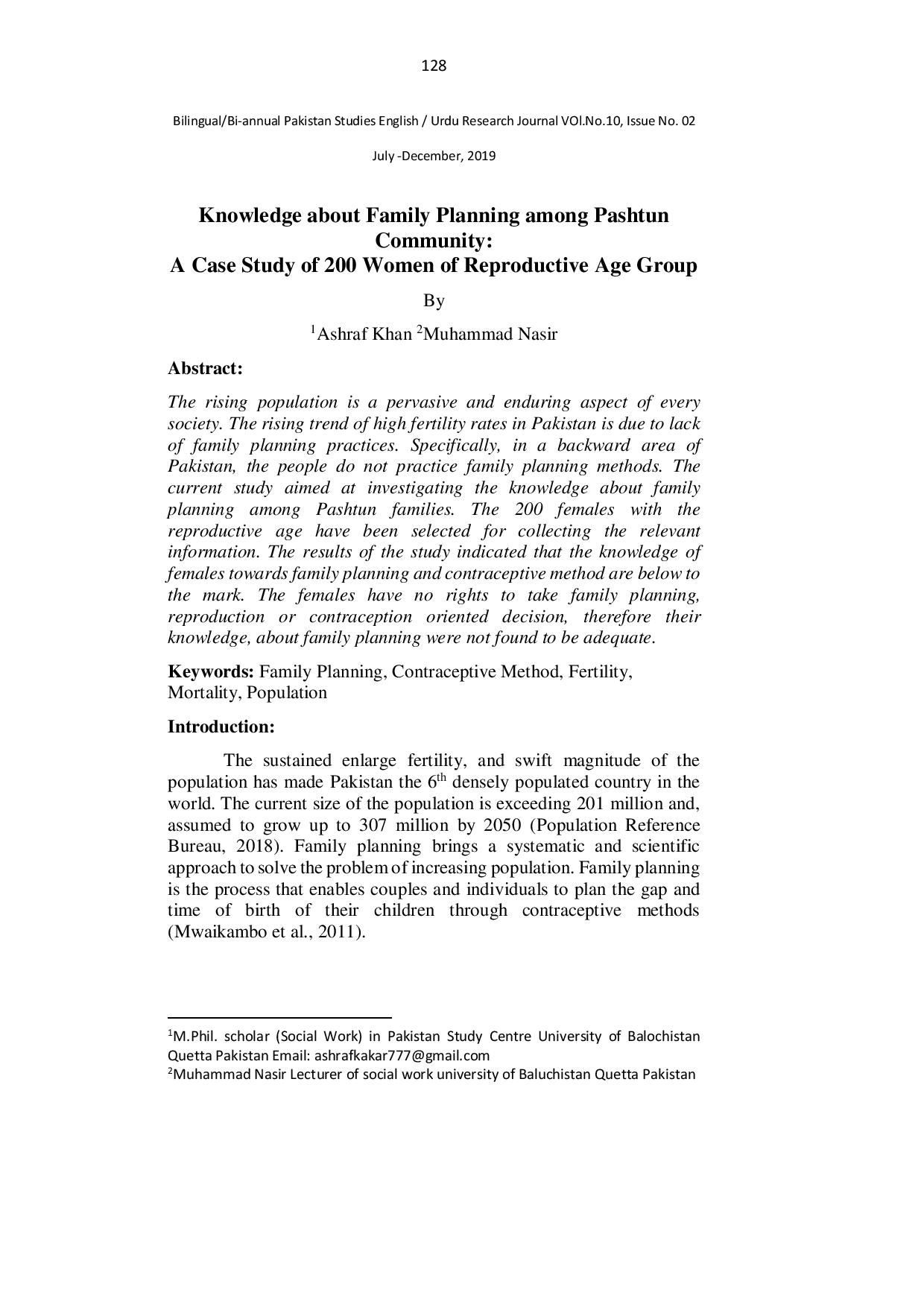Knowledge about Family Planning among Pashtun Community A Case Study of 200 Women of Reproductive Age Group
Keywords:
Family Planning, Contraceptive Method, Fertility, Mortality, PopulationAbstract
The rising population is a pervasive and enduring aspect of every
society. The rising trend of high fertility rates in Pakistan is due to lack
of family planning practices. Specifically, in a backward area of
Pakistan, the people do not practice family planning methods. The
current study aimed at investigating the knowledge about family
planning among Pashtun families. The 200 females with the
reproductive age have been selected for collecting the relevant
information. The results of the study indicated that the knowledge of
females towards family planning and contraceptive method are below to
the mark. The females have no rights to take family planning,
reproduction or contraception oriented decision, therefore their
knowledge, about family planning were not found to be adequate.
References
Ali, A. A., Okud, A. (2013). Factors affecting unmet need for family
planning in Eastern Sudan.BMC Public Health;13(1), 102.
Ayub, A., Kibria, Z., & Khan, F. (2015). Assessment of Knowledge,
Attitude andContraceptive use in Married Women of
Peshawar. J Dow Univ Health Sci, 9(1), 89-93.
Bahar, S., Khalid, R., Khan, S. A., Naseemullah, N., &Batool, N.
(2017). Challenges and experiences of lady health workers
working in polio campaigns in district Nowshera, Khyber
Pakhtunkhwa, Pakistan. Pakistan Journal of Public Health, 7(2),
-78.
Casterline, J. B., &Sinding, S. W. (2000). Unmet need for family
planning in developing countries and implications for
population policy. Population and development review,
(4), 691-723
Fahim, F., Nabeel, N., &Utman, N. (2012). Trends in maternal mortality
in tertiary care hospital in Peshawar-Pakistan. Journal of
Postgraduate Medical Institute (Peshawar-Pakistan), 26(4).
Mwaikambo, L., Speizer, I. S., Schurmann, A., Morgan, G., & Fikree,
F. (2011). What works in family planning interventions: a
systematic review? Studies in family planning, 42(2), 67-82.
Nishtar, S., &Amjad, S. (2009). Synergizing Health and Population in
Pakistan. Journal of Pakistan Medical Association, 59 (9).
Pegu, B., Gaur, B. P. S., Sharma, N., & Santa Singh, A. (2017).
Knowledge, attitude and practices of contraception among
married women. International Journal of Reproduction,
Contraception, Obstetrics and Gynecology, 3(2), 385-388.
Population Reference Bureau-2018 World Population Data Sheet.
Population Reference Bureau (2010). Contraceptive Security for Policy
Audiences: An Overview. www.prb.org.
Sathar, Z. (2011). Fertility prospects in Pakistan. United Nations
Department of Economics and Social Affairs, Population
Division, Expert Paper no. 2011/7, New York.
Shah, N. M., Wang, W., &Bishai, D. M. (2011). Comparing private
sector family planning services to government and NGO services
in Ethiopia and Pakistan: how do social franchises compare
across quality, equity and cost? Health policy and planning,
(1), 63-71.
Statistics Division. (2010-11 and 2011-12). Contraceptive
Performance for the year. Government of Pakistan.
Pakistan Bureau of Statistics, Islamabad.



